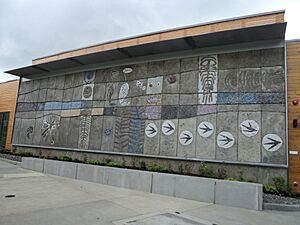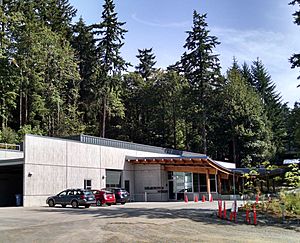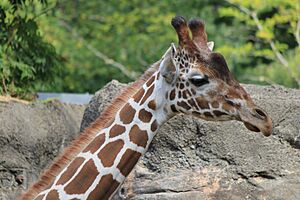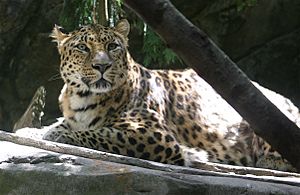Oregon Zoo facts for kids
 |
|
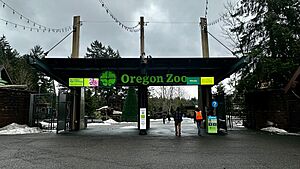
Main entrance in January 2024.
|
|
| Date opened | 1888 |
|---|---|
| Location | Washington Park, Portland, Oregon, United States |
| Land area | 64 acres (26 ha) |
| Coordinates | 45°30′30″N 122°42′53″W / 45.50833°N 122.71472°W |
| No. of animals | 1,800 |
| No. of species | 232 |
| Annual visitors | 1.7 million |
| Memberships | AZA WAZA |
| Major exhibits | The Great Northwest, Africa Savanna, Africa Rainforest, Elephant Lands |
The Oregon Zoo is a popular zoo located in Portland, Oregon, United States. It sits within Washington Park, about two miles southwest of downtown Portland. The zoo first opened in 1888, making it the oldest zoo west of the Mississippi River.
This 64-acre zoo is owned by the local Metro government. It is home to over 1,800 animals from more than 230 different species. This includes 19 species that are endangered and 9 that are threatened. The zoo also has many beautiful plants and special gardens. You can even ride the Washington Park & Zoo Railway inside the zoo!
The Oregon Zoo is one of Oregon's biggest and most loved attractions. In 2018, over 1.7 million people visited the zoo. It is a proud member of the Association of Zoos and Aquariums and the World Association of Zoos and Aquariums.
Contents
History of the Oregon Zoo
How the Zoo Started
The Oregon Zoo began in 1888. This makes it the oldest zoo in North America west of the Mississippi River. It all started with two bears, a brown bear and a grizzly. A man named Richard Knight, who used to be a sailor, bought them. He kept his growing animal collection behind his drug store.
When caring for the animals became too much work, Knight wanted to sell them to the city of Portland. The city offered him two circus cages instead. They let him put the bears in these cages at City Park, which is now called Washington Park.
Knight and his friends still had to feed and care for the bears. Five months later, he offered to give the bears and their cages to the city. The Portland City Council accepted his offer on November 7, 1888. This was the start of the Portland Zoo. It was in Washington Park and sometimes called the Washington Park Zoo.
By 1894, the zoo had over 300 animals. In 1925, the zoo moved to a new spot within Washington Park. This area is now where the Portland Japanese Garden is located.
Moving to a New Location
The zoo moved again in 1958 and 1959 to its current home. This new spot was in Hoyt Park, next to Washington Park. Later, these two parks became one big Washington Park. The Portland Zoo Railway was built to connect the zoo to its old location and other attractions.
The zoo moved its animals in stages over more than a year. The first animals arrived in spring 1958. The zoo opened to visitors in June 1958, the day after the first part of the Zoo Railway opened. During this time, the new zoo was only open on weekends. Most animals were still at the old site. The old zoo stayed open for a few more months.
Opening at Washington Park
The zoo at its current location fully opened on July 3, 1959. It was renamed the Portland Zoological Gardens, but most people still called it the Portland Zoo. The elephants and big cats moved to the new zoo in November. A new freeway exit was built nearby to make it easier to get to the zoo.
Famous Elephants
The zoo became very popular in 1953 when Rosy, an Asian elephant, arrived. The zoo became world-famous in 1962 when an Asian elephant named "Packy" was born. He was the first elephant born in the Western Hemisphere in 44 years. Packy was also the tallest Asian elephant in the United States at 10.5 feet tall.
A total of 28 more elephant calves have been born at the Oregon Zoo. Seven of these were fathered by Packy. This makes the Oregon Zoo's elephant breeding program one of the most successful in the world. On August 23, 2008, Rose-Tu, who was Rosy's granddaughter, gave birth to a son named Samudra. Samudra was the first third-generation elephant born in a zoo in North America.
In 1962, the year Packy was born, 1.2 million people visited the zoo. Over the next few years, the number of animals and visitors went down. However, attendance started to grow again later. Packy passed away in February 2017 after a long illness.
Zoo Management Changes

Until 1971, the city ran the zoo. Then, the Portland Zoological Society managed it. In 1976, local voters approved a plan for the zoo to be taken over by the Metropolitan Service District (now called Metro). Metro officially took ownership of the zoo on July 1, 1976. Metro has continued to expand the zoo with help from donors and volunteers.
Later in 1976, Metro renamed the zoo the Washington Park Zoo after a contest. The railway was renamed the Washington Park and Zoo Railway two years later. The number of visitors began to increase again.
The Oregon Zoo Today
The Metro Council changed the zoo's name to the Oregon Zoo in April 1998. In September of that year, the zoo became easy to reach by the MAX light rail system. The Westside MAX line opened with an underground Washington Park station right at the zoo.
In November 2008, voters approved $125 million to improve the zoo. This money helped update exhibits and teach more people about conservation. The zoo had a record 1.6 million visitors in 2008-2009, partly because of another baby elephant's birth. The zoo continued to attract many visitors, with over 1.7 million in 2018.
Zoo Exhibits
Africa Savanna
The Africa Savanna exhibit is 2.5 acres. In September 2009, a new section called "Predators of the Serengeti" opened. This area used to house Muskoxen and Grizzly Bears. The zoo now has lions again, which came from other zoos.
Discovery Plaza
This exhibit once had a pair of Amur leopards. Boris, a male leopard, was one of the oldest Amur leopards in zoos. He passed away in October 2018.
Great Northwest

Black Bear Ridge is home to three black bears named Tuff, Dale, and Cubby. They arrived in April 2010. Another bear, Takota, passed away in 2023 during a medical procedure.
Primate Forest
The zoo was home to Inji, the world's oldest Sumatran orangutan. She was humanely cared for until her passing in January 2021 when her health declined.
Getting to the Zoo
The Washington Park light rail station provides easy access to the Oregon Zoo. You can take the MAX Light Rail to get there.
Conservation Efforts

The Oregon Zoo works with wildlife groups to help save animals that are in danger. These include California condors, western pond turtles, northern leopard frogs, and different types of butterflies like the Oregon silverspot and Taylor’s checkerspot.
The zoo also helps monitor the American pika. It was the first zoo to successfully breed critically endangered Columbia Basin pygmy rabbits and Oregon silverspot butterflies.
In 2012, the Oregon Zoo became the first zoo to get blood samples from polar bears without using anesthesia. This helped start an important polar bear conservation program. The zoo now works with the U.S. Geological Survey to study polar bear diets and movements. In Borneo, the zoo helps protect elephants and orangutans by supporting rangers and working with local groups.
California Condors: Helping a Rare Bird
In 2001, the zoo joined the U.S. Fish and Wildlife Service’s California Condor Recovery Program. California Condors lay only one egg every one to two years, so they reproduce slowly. In 2003, the first six condor breeding pairs came to the zoo's Johnsson Center for Wildlife Conservation.
As of 2019, 79 chicks have hatched at the zoo. 56 of these birds have been moved to outdoor pens to prepare for release into the wild. Over 50 condors raised at the Oregon Zoo have been released.
The zoo also teaches people about safe hunting practices. This helps protect condors and other wildlife from lead poisoning, which is a major cause of condor deaths in the wild.
Saving Frogs and Turtles
From 1998 to 2012, the zoo helped with efforts to save endangered Oregon spotted frogs. Now, they work on a program to raise and release northern leopard frogs. Frog eggs are collected and hatched at the zoo or at the Cedar Creek Correction Center. Young frogs are then released into the wild to help create new populations. This project works with other zoos to save Pacific Northwest frog species. These frogs are in danger because of habitat loss, new predators, and a harmful fungus.
The Oregon Zoo's Western Pond Turtle Recovery Project has helped create two new populations of western pond turtles. These turtles were almost gone in the Columbia River Gorge because of invasive bullfrogs. Baby pond turtles are collected and raised at the zoo until they are big enough to be safe in the wild. Since 1990, over 1,500 turtles have been released in the Columbia Gorge.
Butterfly Conservation
In 1999, the Oregon Zoo and Seattle's Woodland Park Zoo started a program to raise Oregon silverspot butterflies. This species was once found from California to British Columbia but is now very rare. About 2,000 butterflies are raised from larvae and released each year on the Oregon coast. For this work, the two zoos won the 2012 AZA North American Conservation Award. In 2019, the Oregon Zoo successfully bred a captive silverspot butterfly for the first time, producing many healthy offspring.
The zoo also works with the Coffee Creek Correctional Facility. Inmates volunteer to help raise and care for the critically endangered Taylor's checkerspot butterfly. Their habitat has been greatly reduced by human development. The project has raised and released over 28,000 Taylor's checkerspot butterflies.
Borneo Elephants: Protecting Their Home
The Oregon Zoo's program for Borneo Elephants helps projects in Sabah, Malaysia. These projects aim to reduce conflicts between humans and wildlife. They also create safe paths for elephants and other animals in areas where their homes have been changed. The zoo works with Seratu Aatai to help people and elephants live together. They do this through research and teaching local communities.
In 2015, the Woodland Park Zoo, Houston Zoo, Oregon Zoo, and HUTAN-KOCP formed the “Borneo Elephant Zoo Alliance.” Their goal is to help Bornean elephants survive in the wild. The alliance focuses on learning more about elephants and reducing conflicts with humans. The Oregon Zoo's work with HUTAN-KOCP has recently focused on protecting and replanting forests for both elephants and orangutans.
Notable Events
On July 4, 1970, an unfortunate event occurred when individuals entered the zoo after hours. One person was seriously injured by the zoo's two lions. The next night, one of the individuals returned and harmed both lions. This incident caused a public outcry, and many donations were made to help the zoo replace the lions.
In April 2000, Rose-Tu, a female elephant born at the zoo, experienced a difficult situation with her handler. This led to a law called the Rose-Tu law, signed in 2001. This law made Oregon the first U.S. state to recognize the connection between harm to animals and violence toward people. It also increased penalties for harming animals.
In December 2012, it was revealed that the newborn elephant Lily was owned by a private company. After many people expressed concern, the zoo raised money to buy both Lily and her father, Tusko, for $400,000 in February 2013.
In June 2014, six tamarin monkeys passed away shortly after arriving at the zoo from a research center. This sad event led to an investigation of the center that had transported the monkeys.
See also
- The Continuity of Life Forms, a mosaic by Portland artist Willard Martin. It was first installed at the zoo's old entrance in 1959 and moved to the zoo's new education center in July 2016.



